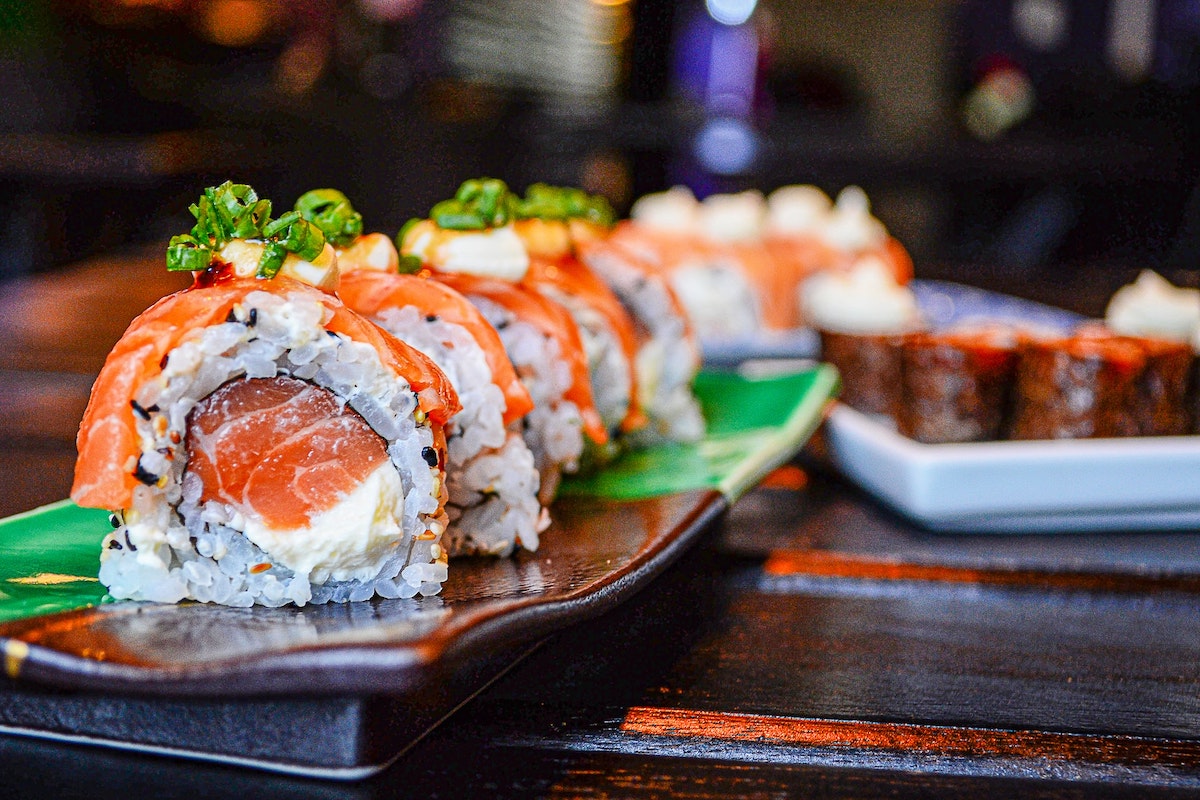Is Sushi Really Good For You? Sushi's Advantages and Disadvantages

Is Sushi Healthy For You? The Pros and Cons of Eating Sushi
Sushi has become one of the most popular dishes worldwide. Whether you're at a Japanese restaurant, a grocery store, or a sushi bar, you're likely to find some sushi offerings.
But is sushi healthy for you?
This blog post will delve into the pros and cons of eating sushi so you can decide whether it's suitable for your diet. We'll cover topics such as nutritional benefits, potential health risks, and sustainability issues so that you can be sure to make the best decision for yourself when deciding whether sushi is the right fit for your lifestyle.
What is sushi?
Sushi is a traditional Japanese dish that consists of cooked vinegared rice (sushi-meshi) combined with other ingredients (neta), usually raw fish, seafood, vegetables, and sometimes tropical fruits.
The neta and sushi-meshi are rolled together with a bamboo mat (makisu) and then cut into bite-sized pieces called nigiri or maki.
Sushi is often touted as a healthy option due to its low-calorie content and the fact that it is typically made with fresh ingredients. However, some potential downsides to eating sushi should be considered.
Sushi can be high in sodium due to soy sauce and other condiments. It can also be challenging to know exactly how fresh the fish is; thus, food poisoning is risky if it needs to be correctly handled or stored.
Finally, some sushi rolls contain eel or mayonnaise, which can be high in fat and calories.
So, while sushi can be a healthy option when eaten in moderation, it's essential to be aware of the potential risks involved in consuming this dish.
The history of sushi
Sushi is a Japanese dish that traditionally consists of cooked rice, vinegar, and fish. It is typically served with pickled ginger, wasabi, and soy sauce.
Sushi can be made with fresh or raw fish and is often prepared using sushi-grade fish.
Sushi originated in Southeast Asia and was first introduced to Japan in the 8th century. It was initially a simple dish of rice and fish preserved in vinegar.
Over time, sushi evolved into the more complex and refined word we know today.
Today, sushi is enjoyed worldwide, and many different types of sushi are available. The most common type of sushi in the US is nigiri sushi, which consists of small balls or ovals of rice topped with a piece of fish or seafood.
Other popular types of sushi include:
- Maki rolls (sushi rolls).
- Sashimi (thinly sliced raw fish or seafood).
- Chirashi (a kind of sushi deconstructed).
While sushi can be a healthy meal option, it is essential to be aware of the potential risks of eating raw fish or seafood. These risks include food poisoning, parasites, and mercury contamination.
If you are pregnant or have a weakened immune system, it is best to avoid eating raw fish or seafood altogether. When choosing sushi at a restaurant, ask about the preparation method to ensure that the fish is fully cooked before consumption.
Is sushi healthy for you?
Sushi is often considered a healthy food, but there are pros and cons to consider before you make it a regular part of your diet.
On the plus side, sushi is typically made with fresh ingredients and lean protein, which are suitable for you. It's also low in calories and sodium and can be a good source of omega-3 fatty acids.
However, sushi can also be high in mercury, harming your health in high doses. And while it's generally low in calories, some sushi can be pretty high in sugar and fat.
So, if you're considering adding sushi to your diet, be sure to do your research and choose options that will best fit your nutritional needs.
The pros and cons of eating sushi
Sushi has been a popular food choice for many people looking for a healthy alternative to traditional fast food options. Sushi is often lauded for its health benefits, but some potential risks are also associated with eating sushi.
Let's take a closer look at the pros and cons of eating sushi.
PROS:
- Sushi is generally a very healthy food choice. It is low in calories and fat and high in protein and omega-3 fatty acids.
- Eating sushi can help you to avoid other unhealthy fast food options.
- Sushi is also very versatile, so you can easily find a variety that meets your dietary needs and preferences.
CONS:
- There is a risk of contracting food-borne illnesses when eating sushi, especially if the fish is not prepared correctly or sourced.
- Some types of sushi can be high in sodium content.
How to make your sushi at home
If you love sushi but are trying to eat healthily, you can make your sushi at home. It's not as difficult as you might think, and you can control the ingredients to ensure it's healthy.
To make your sushi, you'll need the following:
- Sushi rice
- Nori sheets
- Sushi fillings of your choice (raw fish, vegetables, tofu, etc.)
- A sharp knife
- A bamboo sushi mat (optional)
Here's how to make your sushi at home:
- Cook the sushi rice according to the package directions.
- Place a nori sheet on a cutting board or bamboo sushi mat.
- Spread a layer of cooked sushi rice over the nori sheet, leaving about an inch of space at the top and bottom.
- Place your fillings in the center of the rice, and then roll up the sushi tightly using the mat or your fingers.
- Wet the edge of the nori with water or soy sauce to seal it closed.
- Use a sharp knife to cut the sushi into pieces, and serve with soy sauce and pickled ginger (if desired).
Frequently Asked Questions
Is sushi a healthy food choice?
Sushi can be a healthy food choice due to its fresh ingredients and lean protein. However, it's essential to be mindful of the potential risks and choose options that fit your nutritional needs.
Is sushi low in calories?
Sushi is generally low in calories, especially when compared to other fast food options. However, the calorie content can vary depending on the type of sushi and the ingredients used.
Can sushi be high in sodium?
Some types of sushi, particularly those with soy sauce and other condiments, can be high in sodium. It's important to be mindful of your sodium intake, especially if you have specific dietary restrictions.
Is sushi safe to eat?
When prepared and handled correctly, sushi is safe to eat. However, there are potential risks associated with consuming raw fish or seafood, such as food poisoning or parasite infections.
Can sushi help with weight loss?
Sushi can be a part of a weight loss diet due to its low-calorie content and protein-rich ingredients. However, it's crucial to monitor portion sizes and choose healthier sushi options.
Is sushi high in mercury?
Some types of fish used in sushi, such as tuna and swordfish, can be high in mercury. It's advisable to consume these types of fish in moderation, especially for pregnant women or those with specific health concerns.
Can sushi be a source of omega-3 fatty acids?
Yes, certain types of fish used in sushi, such as salmon and mackerel, are rich in omega-3 fatty acids, which have various health benefits. Including these types of sushi in your diet can be beneficial.
Can sushi be a good option for vegetarians?
Sushi can be a good option for vegetarians as there are vegetarian sushi rolls available that contain vegetables, tofu, or other plant-based ingredients.
Can sushi be sustainable?
The sustainability of sushi depends on the sourcing and types of fish used. It's important to choose sushi that is made with sustainably sourced fish to support ocean conservation efforts.
Can I make sushi at home?
Yes, you can make sushi at home. It requires some practice and basic ingredients like sushi rice, nori sheets, and fillings of your choice. There are numerous resources available online with step-by-step instructions.
Interesting Facts
Sushi originated in Southeast Asia and was introduced to Japan in the 8th century.
The word "sushi" actually refers to the seasoned rice used in the dish, not the fish or seafood.
The most common type of sushi in the US is nigiri sushi, which consists of small balls or ovals of rice topped with fish or seafood.
Sushi is traditionally eaten with chopsticks, but it's also acceptable to eat it with your hands.
Sushi has gained popularity worldwide and has evolved to include various types and creative combinations of ingredients.
Related Studies
Risk of Vibrio Infection from Consumption of Raw Seafood Including Sushi in South Korea
This study investigates the risk of Vibrio infection associated with the consumption of raw seafood, including sushi, in South Korea. It highlights the importance of proper handling and storage of raw seafood to prevent foodborne illnesses.
Link: https://pubmed.ncbi.nlm.nih.gov/29441799/
Mercury Levels in Commercially Available Sushi in California
This study analyzes the mercury levels in commercially available sushi in California to assess the potential exposure to mercury through sushi consumption. It emphasizes the need for monitoring and regulation to ensure food safety.
Link: https://pubmed.ncbi.nlm.nih.gov/22175140/
Nutritional Composition of Sushi Prepared with Different Fish Species
This study examines the nutritional composition of sushi prepared with different fish species. It compares the nutrient profiles, including protein, fat, and omega-3 fatty acid content, to provide insights into the nutritional value of sushi.
Link: https://pubmed.ncbi.nlm.nih.gov/26708423/
Food Safety Hazards in Sushi: A Review
This review explores the food safety hazards associated with sushi consumption, focusing on potential microbiological risks, parasites, and chemical contaminants. It emphasizes the importance of proper handling, storage, and sourcing of ingredients to ensure food safety.
Link: https://pubmed.ncbi.nlm.nih.gov/23391863/
Assessment of Mercury Contamination in Sushi from Ecuadorian Restaurants in Madrid (Spain)
This study assesses the mercury contamination levels in sushi samples from Ecuadorian restaurants in Madrid, Spain. It highlights the importance of monitoring and controlling mercury levels in seafood to protect consumer health.
Link: https://pubmed.ncbi.nlm.nih.gov/31827007/
Conclusion
Eating sushi can be a healthy option if you choose the right ingredients. However, eating it has some risks that cannot be overlooked.
Overall, if you select low-sodium and low-fat options, sushi can offer many nutritional benefits including plenty of protein, vitamins, and minerals.
As always, moderation is essential when making your diet choices, so enjoy sushi in moderation for the best health results.
Visit our website today! 🎉
We have a wide variety of articles, studies, and recipes on a variety of topics. We are sure you will find something that interests you.
So what are you waiting for? Visit our website today and start learning! 📖
